The Adventure of Logmar's Magellan 65, and how a Danish 65mm camera became involved with "Tenet" | Read more at in70mm.com The 70mm Newsletter |
| Summary written by: Thomas Hauerslev | Date: 18.10.2023 |
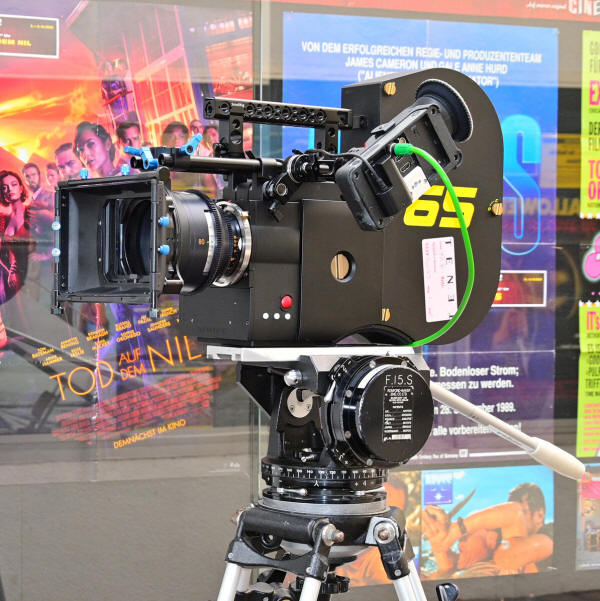 Magellan
65 camera. Picture: Thomas Hauerslev Magellan
65 camera. Picture: Thomas HauerslevSince the production of Christopher Nolan's "Tenet", things have been rather quiet about the new Danish 65mm camera, the Magellan 65. Tommy Madsen, the engineer, and owner of the Logmar company, has in no way been idle, however. Since 2019/2020 he has rebuilt some parts and improved the prototype camera in many ways. Improvements include better balance of the unique mirror shutter and better viewfinder quality. The initial film magazine could hold 400 feet of 65mm film. 400 ft. capacity turned out to be a little on the short side, and a new larger 500 ft. magazine is in development. WhitePoint Optics based in Helsinki developed a new lens mount dubbed WPLM together with a complete series of lenses to specifically work with the Magellan camera. All this and more was the subject of a 1-hour live presentation about the Magellan 65 on Sunday, October 8, 2023. The presentation was part of the annual Todd-AO 70mm film festival at the Schauburg Cinerama cinema in Karlsruhe, Germany. The Todd-AO Festival is not complete without a lecture, which this year was about this 65mm camera. Festival organizers had invited Logmar's Product Test Manager Orla Nielsen, DFF, to give a 1-hour presentation summarizing the development history of the camera as well as recent modifications. On top of that, he would also share some recollections from being on the "Tenet" film set with the Magellan 65 camera. The presentation included authentic test footage, 65mm and 70mm film clips as well as test footage presented digitally as DCP. As "icing on the cake", Orla gave an open-air live demonstration of the camera in the biergarten outside the cinema. With a roll of the 65mm film in the magazine, the audience got a hands-on experience to see 65mm film spinning in the camera. • Go to gallery Magellan 65 Presentation in Karlsruhe, 2023 • Go to Designing the Magellan 65 Camera • Go to A new hand-held 65mm Camera At the start of the presentation, Orla summarized the unique design ideas of this MOS ("mit out sound") Magellan camera. A small, handheld, very compact camera for 65mm negative use with (relatively) low weight, electronic view finder (which is EXCELLENT during low-light scenes). The electronic Magellan viewfinder can also record what is being photographed, and transmit it via WiFi, or via a cable to a projector. The birth of this remarkable Magellan 65 camera began nearly 10 years ago, on Tommy's kitchen table. Development began following the succesful launch of Tommy's acclaimed Logmar Chatham Super 8 camera. Logmar manufactured parts to build 10-12 65mm cameras and have around 20 65mm magazines ready. At this moment two cameras are finished, and two more are close to being finished and ready to go. All parts of the camera have been manufactured in Denmark. "The first version of the camera utilized traditional Hasselblad lenses, which made it easy to use. As mentioned earlier, a new mount - and re-housed Hasselblad lenses - has been developed with Whitepoint Optics. For testing, Eastman Kodak has been very kind and supportive and provided us around 40 boxes of Kodak Vision3 65mm negative film - including free processing and scanning with Kodak in London. It is very expensive to use, but you must do it and run some film through the camera to advance development. Most of the film Kodak donated is 50D/5203 film. The most popular film on a film production is a 200T/5213 Tungsten, a 250D/7207 daylight film, and a 500T/5219 for low-light filming. The 50D/5203 ISO is the slowest film, and it has the shortest range of contrast, so it can be a little hard to work with. You must have a lot of fill light on this on the set for doing nice pictures. But also, the lower the ISO, the sharper the pictures are." | More in 70mm reading: Designing the Magellan 65 Camera A new hand-held 65mm Camera The Magellan 65 receives Technical & Scientific Achievement Award From Frederikshavn to Hollywood 17. Todd-AO 70mm-Festival 2023 Todd-AO Festival Home "Tenet" Production Info |
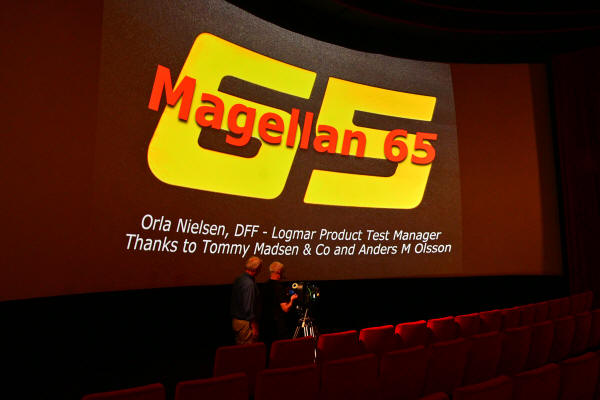 Magellan
65 presentation about to begin. Picture: Thomas Hauerslev Magellan
65 presentation about to begin. Picture: Thomas Hauerslev"Several rolls of 65mm film have been exposed around Frederikshavn on the coasts of Denmark. This was done to test for image steadiness, light leaks etc. One test we did was an "homage" to the very first film by the Lumiere Brothers - "L’Arrivée d’un train en gare". A train approaching the camera photographed in Hulsig, just south of Skagen. Tommy is also appearing with his 8mm camera in one scene. As expected, there were some light leaks around the edges of the magazines which had to be fixed. One of our light-leak tests was on the roof of a tall building in Frederikshavn on a bright sunny day. Just Tommy and I with the camera. The point is, if there is a problem, you fix it." Orla continued talking about the unique guillotine shutter. A mirror between the film and the lens moves up and down reflecting the image on a video camera, as the film is exposed. The reason for that is it takes up much less space (and weight) compared to a rotating mirror, which is normally used in a reflex camera. The Magellan 65 was launched officially at the CineGear exhibition in May 2018 on the Paramount studio lot in Los Angeles. Among the guests at the time visiting the Logmar booth were cinematographers Hoyte van Hoytema ("Tenet") and Linus Sandgren ("No Time to Die"). At that point the camera was not actually running just yet, but it caught the attention of the industry. The next public presentation was the European premiere in Karlsruhe later in October, followed by a presentation at the Cameraimage exhibition in Poland in November. In January 2019 a very proud Tommy accepted the IMIS Technical & Scientific Achievement Award in London for the development of the camera. It all happened very quickly. The CineGear presentation created a lot of excitement. "Hoyte van Hoytema was about to begin production on "Tenet” and wanted to use the camera. Hoyte sent us an invitation to come to Hollywood with the camera. That did put some pressure on Tommy's shoulders to make one camera ready for work. Hoyte wanted to use the camera in a real production environment with crew and actors. Before that started we spent 10 days with Panavision testing and prepping the camera for use. We could use all the film we needed. One day we were ready to run a roll of test film at the Warner Brothers lot to demonstrate for the executives and top guys. When our test roll was shown, the image was jumping, jumping, and jumping. It was sharp and fine, but it was jumping like crazy. Something was wrong with the movement obviously, but Tommy managed to adjust the camera. The problem was fixed, and they were all very nice to us." | |
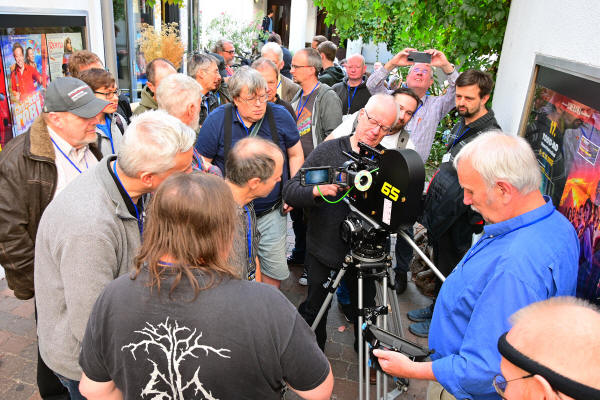 The
Magellan 65 demo was a popular event at the Todd-AO Festival. Picture:
Thomas Hauerslev The
Magellan 65 demo was a popular event at the Todd-AO Festival. Picture:
Thomas Hauerslev"Hoyte was very enthusiastic and wanted to use the camera for dynamic things. He is a strong man who can take an IMAX camera on his shoulder and use it handheld, so our little camera was very easy to use for him. It's only 13-15 kilo." Orla continued to talk about working on the set of "Tenet". It was a huge production with hundreds of people, many trucks, and closed streets. The Magellan was part of the London shoot together with Panavision's System 65 camera, but none of the Magellan footage of that day ended up in the film". In Los Angeles we shot tests outside an abandoned parking structure which was used as a 'Tenet' film set. We needed to make some strobing tests alongside the System 65 camera. Basically, a pan and a tilt with both cameras with a 40mm lens to look for differences. The Panavision uses Leitz lenses which are very, very good, but not so hard in contrast as our Hasselblad lenses. The were no really differences, and I have the processed 70mm footage from our camera." "On a different fight scene, we were ready with the camera on a dolly. 'All good. Start. Go!' Camera sounds fine, and then the camera broke down - 'KARBUNKL - film, crunch'. A big 'crash' sound after only 5 seconds of running, and 65mm film quickly film piled up inside the camera. The entire team between 20 and 30 people all said 'Ahhh', and they were very sorry for us. We took the camera away and removed the film in a dark room. Tommy fixed the shutter later and we could continue. In Denmark we filmed on the boats on the Baltic sea. One day the Magellan was ready on a long dolly track. I had been checking the filters were sitting properly, making sure you do not get reflections in the lens. I was just making sure that that this wouldn't happen. This was also re-checked by a person from the set. But eventually Hoyte decided to use the IMAX camera instead for that scene. There are so many people working on a film set, almost unlimited number of boxes with lenses, camera gear and camera equipment must be moved on and off the boats every day. Cameras are serviced and fixed on the spot etc. A huge amount of logistics must be taken into account and the days are very long. It feels just like a military operation, where everything is planned. It was working very, very well. "Every day the production exposed around 20.000 feet of 65mm film (= ca. 3 hours of 5 perf 65mm film or ca. 1 hour of IMAX 65mm 15 perf). The exposed 65mm negative was sent to FotoKem in Los Angeles. Three days later positive prints with synchronized sound was returned to be seen and evaluated by Christopher Nolan and Hoyte. There were two mobile (container) cinemas on set for viewing dailies. One cinema was equipped with a Philips DP75 for the 70mm footage, and one for 35mm for viewing IMAX footage, which had been optically reduced to 35mm film. We were on location several times during production. Maybe for a little more than a month in total, with all expenses, airfares and hotels paid for by Warner Brothers. Two studio visits in Hollywood, on an airfield in California, and on location in London (UK), and in Rødby in Denmark (for the off-shore windmill scenes). It was a very exciting experience, and I could have stayed there all the time, but Tommy needed to get home and work on the camera." | |
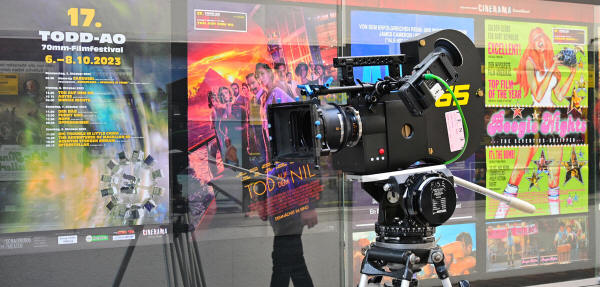 Magellan
65 camera. Picture: Thomas Hauerslev Magellan
65 camera. Picture: Thomas HauerslevOrla also mentioned news from film manufacturer ORWO (short for ORiginal WOlfen) in Bitterfeld-Wolfen near Leipzig, Germany. ORWO has announced a new line 65mm negative stock to be introduced in competition with Eastman Kodak's 65mm products. The future for 65mm production looks brighter than ever. So hopefully, the Magellan 65 will have a lot of large format film work to look forward to. The presentation lasted approximately 1 hour, including 45 minutes of talk, and 16 minutes of large format film, DCP and video. As the Schauburg presentation came to an end, it was time for a few audience questions before the camera was moved outside for the live demonstration. Film Clips Shown: • DCP: "L’Arrivée d’un train en gare de Hulsig" (2:39) Filmed 19.08.2019 in Hulsig and Skagen • DCP: "Dorte goes to Hollywood" (3:20) "Starring" Dorte Koch and her dog Minnie. Filmed 16.01.2020 on the beach in Lønstrup • 65mm negative test from the roof of Logmar in Frederikshavn • 70mm positive test from parking lot in Los Angeles • 3x phone videos embedded in PP presentation (20 sec) + (51 sec) + (27 sec) Fun fact: The Magellan is named after a bird. Thanks to Anders M. Olsson in Sweden and Tommy Madsen. | |
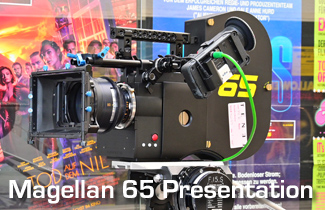 • Go to The Adventure of Logmar's Magellan 65, and how a Danish 65mm camera became involved with "Tenet" | |
| Go: back - top - back issues - news index Updated 22-01-25 |
